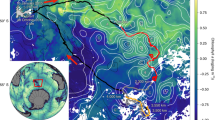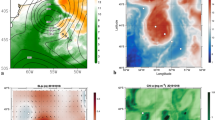Abstract
Sea surface temperature (SST) is a critical control on the atmosphere1, and numerical models of atmosphere–ocean circulation emphasize its accurate prediction. Yet many models demonstrate large, systematic biases in simulated SST in the equatorial ‘cold tongues’ (expansive regions of net heat uptake from the atmosphere) of the Atlantic2 and Pacific3 oceans, particularly with regard to a central but little-understood feature of tropical oceans: a strong seasonal cycle. The biases may be related to the inability of models to constrain turbulent mixing realistically4, given that turbulent mixing, combined with seasonal variations in atmospheric heating, determines SST. In temperate oceans, the seasonal SST cycle is clearly related to varying solar heating5; in the tropics, however, SSTs vary seasonally in the absence of similar variations in solar inputs6. Turbulent mixing has long been a likely explanation, but firm, long-term observational evidence has been absent. Here we show the existence of a distinctive seasonal cycle of subsurface cooling via mixing in the equatorial Pacific cold tongue, using multi-year measurements of turbulence in the ocean. In boreal spring, SST rises by 2 kelvin when heating of the upper ocean by the atmosphere exceeds cooling by mixing from below. In boreal summer, SST decreases because cooling from below exceeds heating from above. When the effects of lateral advection are considered, the magnitude of summer cooling via mixing (4 kelvin per month) is equivalent to that required to counter the heating terms. These results provide quantitative assessment of how mixing varies on timescales longer than a few weeks, clearly showing its controlling influence on seasonal cooling of SST in a critical oceanic regime.
This is a preview of subscription content, access via your institution
Access options
Subscribe to this journal
Receive 51 print issues and online access
$199.00 per year
only $3.90 per issue
Buy this article
- Purchase on Springer Link
- Instant access to full article PDF
Prices may be subject to local taxes which are calculated during checkout




Similar content being viewed by others
References
Xie, S.-P. Satellite observations of cool ocean-atmosphere interaction. Bull. Am. Meteorol. Soc. 85, 195–208 (2004)
Richter, I. & Xie, S.-P. On the origin of equatorial Atlantic biases in coupled general circulation models. Clim. Dyn. 31, 587–598 (2008)
Wittenberg, A. T., Rosati, A., Lau, N. C. & Ploshay, J. J. GFDL’s CM2 global coupled climate models. Part III: Tropical Pacific climate and ENSO. J. Clim. 19, 698–722 (2006)
Jouanno, J., Marin, F., Du Penhoat, Y., Sheinbaum, J. & Molines, J.-M. Seasonal heat balance in the upper 100 m of the equatorial Atlantic ocean. J. Geophys. Res. 116, C09003 (2011)
Xie, S. On the genesis of the equatorial annual cycle. J. Clim. 7, 2008–2013 (1994)
Praveen Kumar, B., Vialard, J., Lengaigne, M., Murty, V. S. N. & McPhaden, M. J. TropFlux: air-sea fluxes for the global tropical oceans—description and evaluation. Clim. Dyn. 38, 1521–1543 (2012)
Mitchell, T. P. & Wallace, J. M. The annual cycle in equatorial convection and sea surface temperature. J. Clim. 5, 1140–1156 (1992)
Trenberth, K. E., Caron, J. M. & Stepaniak, D. P. The atmospheric energy budget and implications for surface fluxes and ocean heat transports. Clim. Dyn. 17, 259–276 (2001)
Wang, B. & Fu, X. Processes determining the rapid reestablishment of the equatorial Pacific cold tongue/ITCZ complex. J. Clim. 14, 2250–2265 (2001)
Wang, W. & McPhaden, M. J. The surface-layer heat balance in the equatorial Pacific ocean. Part I: mean seasonal cycle. J. Phys. Oceanogr. 29, 1812–1831 (1999)
McPhaden, M. J., Cronin, M. F. & McClurg, D. C. Meridional structure of the seasonally varying mixed layer temperature balance in the eastern tropical Pacific. J. Clim. 21, 3240–3260 (2008)
Moum, J. N. et al. Sea surface cooling at the Equator by subsurface mixing in tropical instability waves. Nature Geosci. 2, 761–765 (2009)
Moum, J. N. & Caldwell, D. R. Local influences on shear flow turbulence in the equatorial ocean. Science 230, 315–316 (1985)
Gregg, M. C., Peters, H., Wesson, J. C., Oakey, N. S. & Shay, T. J. Intensive measurements of turbulence and shear in the equatorial undercurrent. Nature 318, 140–144 (1985)
Lien, R.-C., Caldwell, D. R., Gregg, M. C. & Moum, J. N. Turbulence variability in the central Pacific at the beginning of the 1991–93 El Ninõ. J. Geophys. Res. 100, 6881–6898 (1995)
Inoue, R., Lien, R.-C. & Moum, J. N. Modulation of equatorial turbulence by a tropical instability wave. J. Geophys. Res. 117, C10009 (2012)
Hummels, R. & Dengler, M. B. B. Seasonal and regional variability of upper ocean diapycnal heat flux in the Atlantic cold tongue. Prog. Oceanogr. 111, 52–74 (2013)
Moum, J. N. & Nash, J. D. Mixing measurements on an equatorial ocean mooring. J. Atmos. Ocean. Technol. 26, 317–336 (2009)
Perlin, A. & Moum, J. N. Comparison of thermal variance dissipation rates from moored and profiling instruments at the equator. J. Atmos. Ocean. Technol. 29, 1347–1362 (2012)
McPhaden, M. J. et al. The tropical ocean-global atmosphere observing system: a decade of progress. J. Geophys. Res. 103, 14,169–14,240 (1998)
Moum, J. N., Nash, J. D. & Smyth, W. D. Narrowband high-frequency oscillations at the equator. Part I: interpretation as shear instabilities. J. Phys. Oceanogr. 41, 397–411 (2011)
Smyth, W. D., Moum, J. N., Li, L. & Thorpe, S. A. Shear instability, the descent of the diurnal mixing layer and the deep cycle of equatorial turbulence. J. Phys. Oceanogr (submitted)
Zaron, E. D. & Moum, J. N. A new look at Richardson number mixing schemes for equatorial ocean modeling. J. Phys. Oceanogr. 39, 2652–2664 (2009)
Ohlmann, J. C., Siegel, D. A. & Gautier, C. Ocean mixed layer radiant heating and solar penetration: a global analysis. J. Clim. 9, 2265–2280 (1996)
Swenson, M. S. & Hansen, D. V. Tropical Pacific ocean mixed layer heat budget: the Pacific cold tongue. J. Phys. Oceanogr. 29, 69–81 (1999)
Sun, C., Smyth, W. D. & Moum, J. N. Dynamic instability of stratified shear flow in the upper equatorial ocean. J. Geophys. Res. 103, 10323–10337 (1998)
Osborn, T. R. & Cox, C. S. Oceanic fine structure. Geophys. Fluid Dyn. 3, 321–345 (1972)
NOAA Commerce Department. NOAA gets U.S. consensus for El Niño/La Niña index, definitions. NOAA press release NOAA 03–119 (2003); available at http://www.noaanews.noaa.gov/stories/s2095.htm
Reynolds, R. W. et al. Daily high-resolution-blended analyses for sea surface temperature. J. Clim. 20, 5473–5496 (2007)
Acknowledgements
This work was funded by the National Science Foundation (grants 0424133, 0728375 and 1256620). We thank M. Neeley-Brown and R. Kreth, who were primarily responsible for construction, testing and maintenance of χ-pods, and P. Freitag and NOAA's PMEL mooring group, who helped us to get started with these measurements. We also thank NOAA's NDBC group, who have continued to deploy our χ-pods on TAO moorings. E. Shroyer, S. de Szoeke, K. Benoit-Bird and D. Chelton provided comments on the paper. This is PMEL contribution no. 3970. We dedicate this paper to the memory of our colleague and co-author A. Perlin, who passed away during final revisions, and to the memory of lab engineer R. Kreth.
Author information
Authors and Affiliations
Contributions
J.N.M. wrote the paper. A.P. and J.N.M. did the analysis. J.D.N. has been part of this project since its inception and provided suggestions for analysis. M.J.M. provided advice on the large-scale context of these measurements. All authors contributed suggestions and text at the writing stage.
Corresponding author
Ethics declarations
Competing interests
The authors declare no competing financial interests.
Supplementary information
Supplementary Information
This file contains Supplementary Text and Supplementary Figures 1-4. (PDF 627 kb)
Supplementary Data
A MATLAB data file containing spectral estimates of turbulence quantities derived from raw voltages. (TXT 25372 kb)
Rights and permissions
About this article
Cite this article
Moum, J., Perlin, A., Nash, J. et al. Seasonal sea surface cooling in the equatorial Pacific cold tongue controlled by ocean mixing. Nature 500, 64–67 (2013). https://doi.org/10.1038/nature12363
Received:
Accepted:
Published:
Issue Date:
DOI: https://doi.org/10.1038/nature12363
This article is cited by
-
Persistent mixing bursts in the equatorial Pacific thermocline induced by persistent equatorial waves
Journal of Oceanology and Limnology (2024)
-
Satellite-observed strong subtropical ocean warming as an early signature of global warming
Communications Earth & Environment (2023)
-
Retrospection of heatwave and heat index
Theoretical and Applied Climatology (2022)
-
Mixed layer heat budget in the eastern equatorial Indian Ocean during the two consecutive positive Indian Ocean dipole events in 2018 and 2019
Climate Dynamics (2022)
-
Disentangling the effect of regional SST bias on the double-ITCZ problem
Climate Dynamics (2022)
Comments
By submitting a comment you agree to abide by our Terms and Community Guidelines. If you find something abusive or that does not comply with our terms or guidelines please flag it as inappropriate.



